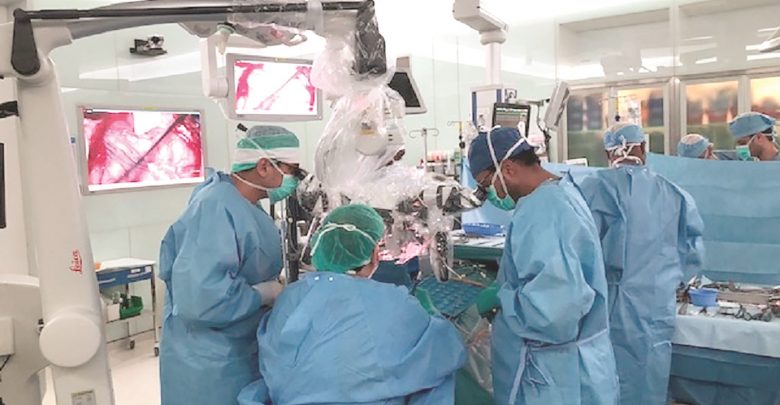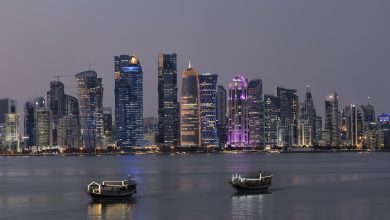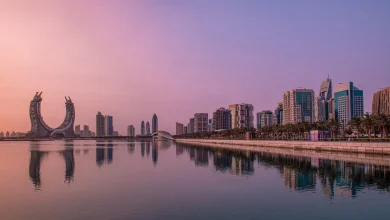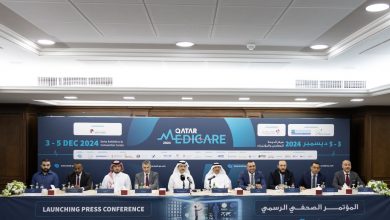
HMC only facility in the region to offer last-resort treatment for Moyamoya patients
«حمد الطبية» تنفرد في المنطقة بتوفير جراحة علاجية لمرض نادر في الدماغ
QNA
Doha: Late last month the neurosurgery team from Hamad Medical Corporation’s (HMC) Hamad General Hospital performed a brain bypass surgery on a 30-year-old patient from the Philippines, marking the tenth procedure performed since the introduction of the Brain Re-Vascularization Program two years ago. HMC is currently the only healthcare provider in the region to offer the surgery, which is a last-resort treatment for patients suffering from symptoms of decreased blood flow due to Moyamoya disease.
“Moyamoya is a progressive disease that does not improve without treatment. It develops over months or years and is caused by blocked arteries at the base of the brain. The rare condition, which is more common in the childhood age group, affects only about one in a million people,” said Dr Sirajeddin Belkhair, Senior Consultant, Neurosurgery and Head of the Neurosurgery Department at Hamad General Hospital.
“The name ‘Moyamoya’ means ‘puff of smoke’ in Japanese and describes the appearance of tiny vessels that form to compensate for the blockage. As the normal blood vessels narrow and become blocked, the condition predisposes affected patients to stroke,” explained Dr Belkhair.
“While Moyamoya itself is not curable, surgery to provide alternative blood flow to the brain prevents related symptoms and can significantly reduce stroke risk. As the arteries become narrower, the brain forms tiny blood vessels to create new pathways for blood to flow,” added Dr Belkhair.
Dr Belkhair explained that while the exact cause of Moyamoya disease is not known, multifactorial inheritance is considered a possible cause because the incidence of the disease is more common in Asian countries, underscoring the significance of HMC’s programme.
“We are still trying to understand the mechanism of developing Moyamoya disease. Some researchers believe it could be due to an inherited defect of cerebral blood vessels. The cause may also be related to associated conditions such as Down syndrome and sickle cell disease. This disease primarily affects children, but it can also occur in adults, with the first symptom often being a stroke,” added Dr. Belkhair.
Dr Ali Ayyad, Senior Consultant, Neurosurgery was the lead surgeon for the recently completed milestone tenth operation. He said surgery is generally recommended for Moyamoya patients with recurrent or progressive TIAs or strokes to prevent further strokes by restoring (re-vascularizing) blood flow to the affected areas of the brain.
“HMC introduced the Brain Re-Vascularization Program in Qatar as a last resort for patients suffering from symptoms of decreased blood flow to the brain. We are the only healthcare provider in the Middle East offering this complex surgery,” said Dr Ayyad.
“While the re-vascularization surgery is primarily for patients with Moyamoya disease who are at risk of suffering from stroke, it can also be used to treat dissecting or fusiform brain aneurysms that don’t respond to conventional therapy. To date, we have performed nine surgeries on patients with Moyamoya disease and one on a patient with dissecting aneurysm,” added Dr. Ayyad.
Dr. Ayyad said that the surgery, which involves taking blood vessels from the scalp of a patient and then completing a craniotomy (making an opening in the skull) and connecting blood vessels from the scalp to blood vessels on the patient’s brain, has been successful in improving the symptoms of patients and increasing blood going to their brains.
The overall prognosis for patients with Moyamoya disease depends on how rapidly vascular blockage occurs, and to what extent. Dr. Belkhair said if a patient is surgically treated before a disabling stroke, even if the condition is severe, it will improve their life expectancy and reduce their risk of stroke, highlighting the importance of HMC’s Brain Re-Vascularization Program.
تمكّن فريق جراحي في مؤسسة حمد الطبية، في أواخر الشهر الماضي، من إجراء عملية تحويلة شريان دماغي لمريض فلبيني يعاني من مرض «مويا مويا»، يبلغ من العمر 30 عاماً. وكانت هذه العملية الجراحية العاشرة منذ بدء برنامج إعادة هيكلة الشرايين الدماغية في مؤسسة حمد الطبية قبل عامين.
وتُعتبر المؤسسة المزوّد الوحيد للرعاية الصحية في المنطقة القادر على توفير هذا النوع من الجراحة، الذي يُعتبر الملاذ الأخير لعلاج هذا المرض.
وأكد الدكتور سراج الدين بالخير -استشاري أول جراحة الأعصاب ورئيس قسم جراحة الأعصاب في مستشفى حمد العام- أن مرض «مويا مويا» هو اضطراب في الأوعية الدموية يحدث تدريجياً على مدى شهور أو أعوام وينجم عن تضيّق في الشرايين في قاع الجمجمة، ولا تتحسن حالة المصاب به من دون العلاج، وهو مرض نادر لا تتجاوز نسبة انتشاره حالة واحدة من بين كل مليون شخص ويعدّ أكثر شيوعاً بين الأطفال.
وقال الدكتور بالخير: «مويامويا» عبارة يابانية تعني «نفخة الدخان»، وهي عبارة لوصف مظهر مجموعة الأوعية الدموية الدقيقة التي تتشكّل لتعويض النقص في إمدادات الدم الناجم عن تضيّق الأوعية الدموية في الدماغ، والذي قد يؤدي بدوره إلى إصابة المريض بالجلطة الدماغية، وعلى الرغم من أن مرض (مويا مويا ) نفسه غير قابل للشفاء فإن العلاج الجراحي يوفر مصدراً بديلاً لتدفق الدم إلى الدماغ ويحدّ من أعراض المرض، وبالتالي يجنّب المريض مخاطر الإصابة بالجلطة الدماغية».
وفي إشارة إلى العوامل الرئيسية المسبّبة لمرض «مويا مويا»، قال الدكتور بالخير: «لا تُعرف على وجه التحديد العوامل المسببة لهذا المرض، إلا أنه يمكن القول إن عوامل وراثية يمكن أن تكون وراء الإصابة به، والشاهد على ذلك انتشار هذا المرض في الدول الآسيوية، الأمر الذي ساعد في إنجاح البرنامج الذي تبنّته مؤسسة حمد الطبية لعلاج هذا المرض».
من جانبه، قال الدكتور علي عيّاد، استشاري أول جراحة الأعصاب ورئيس الفريق الذي قام بإجراء العملية الجراحية للمريض المذكور: «تُعتبر الجراحة العلاج الموصى به لمرضى (مويا مويا) الذين يعانون من نوبات نقص التروية بصورة متكررة أو من الجلطات الدماغية، وذلك من خلال إعادة هيكلة أو ترميم الأوعية الدموية في المناطق المصابة من الدماغ، وبالتالي منع تكرار إصابة المرضى بهذه النوبات والجلطات».
وأضاف الدكتور عيّاد، قائلاً: «لا يقتصر استخدام أسلوب إعادة هيكلة الأوعية الدموية في معالجة مرضى (مويا مويا) المعرضين للإصابة بالجلطات الدماغية فحسب، بل يُعتبر من الحلول العلاجية لحالات مرض تمدّد الأوعية الدموية المشرّحة في الدماغ التي لا تستجيب للطرق العلاجية التقليدية».



